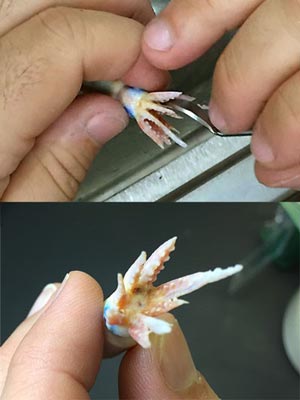Scanning and printing objects of historical and artistic significance is a fantastic way of preserving artifacts. Endeavors like Factum Arte and The Arc/k Project are helping contribute to the conservation and restoration of art and major cultural sites, as well as bring them to the masses using 3D printing. Projects such as MyMiniFactory’s Scan the World are also taking steps towards bringing art into the wider public eye. This is exactly what curator, marine biologist and Cornell Professor Drew Harvell has done with Blaschka glass sculptures that are over a century old.

3D printing the work of Leopold and Rudolf Blaschka
Glassblowers Leopold and Rudolf Blaschka from Dresden, Germany, were able to perfectly mimic nature’s beauty with their glass sculptures in the late 18oo’s. Each piece was meticulously made with colored or painted glass, but looked as though they were plucked from the sea. Many other’s tried to replicate the realism of the living creatures, but few succeeded like the Blaschka’s. Professor Drew Harvell began working with Peter Fried to perfect the 3D scanning of the collection before Statasys reseller CADD Edge stepped in to assist.

Fried essentially asked CADD Edge, “Is 3D printing at a stage to re-create these glass sculptures?”
“Typically, high-end full color 3D printing focuses on either prototyping or medical models, but the historic artifacts that are in museums around the world are also great candidates for this technology. Those collections have pieces that are either deteriorating, under risk of loss otherwise, or as in this case—simply too delicate to move around. So enter 3D printing to enable tactile high-quality replicas of even the most complex pieces.” said Marcus Weddle from CADD Edge, Inc.
There has been remarkable progress toward that objective, thanks to the stunning resolution and full-color capability of the Stratasys J750. This first test print is of Blaschka model B-560, a 2-inch squid sculpture that’s over 130 years old, but now recreated in a durable 3D print that can be easily transported and handled safely.

Very little adjustment went into the initial print, as the J750 3D printer is able to handle incredible detail with 14-micron layer resolution and superior color rendition. The only post-production that was needed was support removal.

“We knew the 3D-imaging and printing of the Blaschka glass figures would be challenging. However, we have been very impressed with the vividness and quality of our first-cut prints from the Stratasys J750. We look forward to more 3D printing activity and hope these prints will help us grow awareness for these beautiful figures.” said Professor Harvell.
Where to from here?
The next step will be to 3D scan the glass objects with transparent and translucent effects to really mimic the sculptures, and to move on to the other objects in the collection, including larger pieces like jellyfish.
Featured image: 3D printed detail. Image: Stratasys



